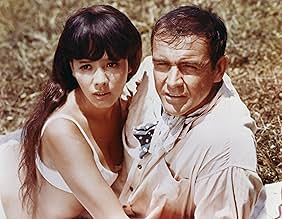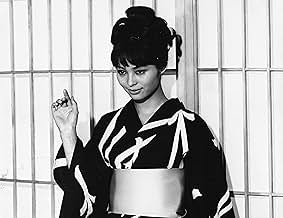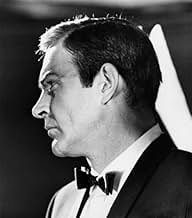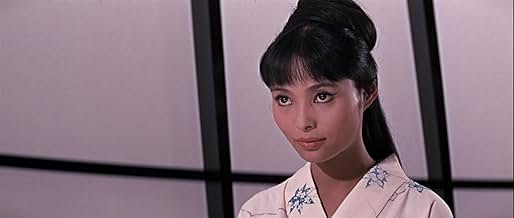जेम्स बॉन्ड और जापानी सीक्रेट सर्विस को अंतरिक्ष अपहरण की एक श्रृंखला के असली अपराधी को ढूंढना और रोकना चाहिए।जेम्स बॉन्ड और जापानी सीक्रेट सर्विस को अंतरिक्ष अपहरण की एक श्रृंखला के असली अपराधी को ढूंढना और रोकना चाहिए।जेम्स बॉन्ड और जापानी सीक्रेट सर्विस को अंतरिक्ष अपहरण की एक श्रृंखला के असली अपराधी को ढूंढना और रोकना चाहिए।
- 1 BAFTA अवार्ड के लिए नामांकित
- 2 जीत और कुल 3 नामांकन
- Tiger Tanaka
- (as Tetsuro Tamba)
फ़ीचर्ड समीक्षाएं
The relocation to Japan for the main action (resulting in impeccable photography courtesy of the renowned Freddie Young, who also contributes an inspired aerial shot of our hero at the center of a rooftop chase/struggle) adds much-needed novelty in the exotic department – though characters tend to be less well developed as a consequence. Tetsuro Tamba is imposing enough as his 'sidekick', but the all-important Bond girls have no distinguishing features – save for Karin Dor, a typical femme-fatale-ish villainess who manages to trap Bond in an unpiloted plane. Similar expansiveness was shown in Ken Adam's elaborate design of Ernst Stavro Blofeld's headquarters, hidden within the crater of a Japanese volcano; other attention-grabbing devices include Bond being 'killed' in the prologue (thus explaining the title), while he's later given an Oriental 'countenance' and even made to 'marry' a Japanese girl (an irrelevant undercover attempt, as it happens – since there is very little interaction between Bond, his local allies and the enemy before the final confrontation in the volcano interior)!
Its plot involving the abduction of space shuttles belonging to the U.S. and Russia, in the hope of provoking a war between the major powers, again plays on the fears of nuclear annihilation palpable during the Cold War era. Incidentally, this is the first time Blofeld himself steps in as chief villain (played with appropriate menace by Donald Pleasence – with a handy piranha-filled stream underneath a sliding bridge to replace the pool-sharks from the previous installment, THUNDERBALL [1965]). By the way, Charles Gray (Blofeld in DIAMONDS ARE FOREVER) appears in a bit here as Bond's ill-fated contact in Japan! The most prominent gadget invented by Q (the ubiquitous Desmond Llewellyn) in this case is an artillery-equipped mini-chopper – employed in a sequence whose filming unfortunately cost an aerial photographer his leg!; there's also a memorably violent brawl which has Bond and his opponent lashing at each other with heavy living-room couches!
The show, then, is climaxed by one of the most spectacular action bouts in the entire saga – for which Bond recruits Tamba's ninjas to fight the minions of SPECTRE; Blofeld, of course, is allowed to go free this time around since he'd be involved in at least three subsequent direct matches with 007. Given that director Gilbert lived up to the challenge of ably following in the footsteps of Terence Young and Guy Hamilton, it was only natural he'd be asked to helm further Bond adventures – though, by the time THE SPY WHO LOVED ME (1977) and MOONRAKER (1979) came along, Roger Moore had firmly established himself in the role.
Bond heads to Japan racing to uncover the true mastermind behind the space-jacking that could see another world war, as British sources believe that the mysterious rocket ship which has seized American and Russian space shuttles originates from there, but those countries believe otherwise than each other for the acts.
Couple of things which made it more the memorable would be that it's the first chance we get to see arch villain SPECTRE Agent #1 Ernst Blofeld's face, than just the hand stroking the cat although the first hour we get enough of that. It's a devilishly meaty Donald Pleasence who just seemed the part of Blofeld. Now who didn't love the hidden lair that was in an inactive volcano, and of course Blofeld's pool of pet piranhas. The inventive gadget novelty was really making a mark, just look the deadly mini-copter named 'Nelly' and the dangerous effects of smoking around others. Strangely enough the (witty) script seemed to spit out a few self-knowing quips involving cigarettes, which became rather odd. Director Lewis Gilbert (who would go on to control the very similar in story-structure "The Spy Who Loved Me" and then following that the plain goofy "Moonraker") does a tersely capable job with a fast moving pace that shifted from one well organized set-piece to another (like the chase on-top of a rooftop in a fishing docks that's masterfully captured by cinematographer Freddie Young) to finally finish on a barnstorming climax (with none other than ninjas) and then a familiarly fitting final frame. Sean Connery might look a little tired (a bit funny trying to make himself look like Japanese under make-up), but remains just as charismatic and fittingly lean when it came to getting down and dirty (Bond and his tussle with Blofeld's massive henchman Hans comes to mind). The bond girls shape up nicely in the form of Akiko Wakabayashi, Mie Hama and the stunning German redhead Karin Dor. Tetsurô Tanba was good as Bond's Japanese counterpart. Bernard Lee, Lois Maxwell and Desmond Llewelyn treat us to their iconic roles. John Barry's classy music score has a smoothly oriental touch, which can get actively copious when called for and theme song "You Only Live Twice" is enticingly sung by Nancy Sinatra.
Bond 5 and Connery once again tackles the role of 007. With American and Soviet space craft mysteriously vanishing from space, both nations are laying the blame at the other's door. Sensing a nuclear war could break out, M assigns Bond to Japan to investigate if there might be a third party stirring the hornets nest. Teaming up with the Japanese secret service, Bond uncovers evidence that SPECTRE is behind the plot to pitch the East and the West against each other.
This organisation does not tolerate failure.
Thunderball had broke box office records for Bond, gadgetry, outlandish stunts and a quip on the tongue had proved most profitable. It was planned originally that On Her Majesty's Secret Service would be number 5 in the series, but a change of tack to go for You Only Live Twice as the story gave producers Broccoli & Saltzman the scope for a giganticus enormous production. However, it may be set in Japan and feature a Bond/Blofeld conflict, but Roald Dahl's script bares little resemblance to Ian Fleming's source novel. Although a massive financial success with a Worldwide gross of over $111 million, Bond 5 took $30 million less than Thunderball. Strange since this is a better film. Can we attribute the drop to it being a space age saga? Maybe, the rebirth of sci-fi was a few years away, and of course Bond had lost some fans who had grown tired, like Connery, of 007 relying on gadgets instead of brains and brawn to complete his missions. There was also the rival Casino Royale production, as bad as it was, to contend with, while the spy boom created by Bond had been overkilled elsewhere and was on the wane.
Extortion is my business. Go away and think it over, gentlemen. I'm busy.
True enough that You Only Live Twice has flaws, though they are far from being film killers if you like the gadgets and hi-techery side of the franchise? Connery announced once production was over that he was leaving the role of Bond behind. He had been close to breaking point after Thunderball, but finally the media circus, typecasting, the fanaticism and the character merely being a cypher for outrageous sequences, led Connery to finally call it a day. His displeasure shows in performance, oh it's professional, very much so, but the swagger and machismo from the earlier films has gone. Although Dahl's script tones down the "cheese" dialogue and unfolds as a plot of considerable World peril worth, characterisations are thinly drawn, making this reliant on production value and action sequences. Thankfully both are top dollar. And the ace up its sleeve is the long awaited face to face meeting of Bond and Blofeld.
The firing power inside my crater is enough to annihilate a small army. You can watch it all on TV. It's the last program you're likely to see.
Ken Adam's set design is fit to grace any epic in film history, as is Freddie Young's photography around the Japanese locales, Barry lays a beautiful Bond/Oriental score all over proceedings and Nancy Sinatra's title song is appealingly catchy. The action is excellently constructed by Gilbert (helming the first of three Bond movies on his CV), with the final battle at Blofeld's volcano crater base full of explosions, flying stunt men, expert choreography and meaty fights. Along the way we have been treated to Ninjas, Piranhas, poison, aeroplane peril and the awesome Little Nellie versus the big boy copter smack down! Then there's that Bond/Blofeld confrontation. Well worth the wait, with Pleasence visually scary with bald head (setting the marker for bald villainy to follow in TV and cinema it seems) and scar across his eye. Pleasence is also very low key with his menace, which is perfect, we don't want pantomime and the scenes with Bond work wonderfully well.
It made less than the film before it and it has fierce critics in Bond and Fleming circles. But it's a Bond film that pays rich rewards on revisits, where the artistry on show really shines through in this HD/Upscale age. 8/10
Finally, we get to see Bloefeld, and it's a bit of a letdown. Donald Pleasance is a fine actor, but he's not quite supervillain material; more of the serial killer variety, in the mold of Peter Lorre. Still, he is by far the superior on-screen version.
The Japanese cast are all outstanding. Special mention should be made of Peter Maivia, grandfather of Dwayne Johson, aka The Rock. He and the stuntmen create a brutal fight scene, second only to the train fight in FRWL, although this is perhaps more inventive.
As for gadgets, outside of the jetpack from Thundrball and Goldfinger's Aston Martin, Little Nellie is the coolest ride. The aerial scenes are spectacular and are one of the highpoints of the whole series.
This film really marks the end of the ultra-cool Bond films. After this, they tend to go down in quality, taken as a whole. Some have better stories and villains, some have better stunts, but they are never the complete package that the earlier films were. Still, this one (along with Goldfinger and Thunderball) would inspire every spy work that would follow; from The Man from U.N.C.L.E. to Our Man Flint, Marvel Comics' Nick Fury, Agent of S.H.I.e.L.D., to the X-Men. Everyone stole an idea from here.
"You Only Live Twice" is business as usual for Bond. Not much new, and Connery seemed bored playing his role (explaining his disappearance in "On Her Majesty's Secret Service"). There is a lot to like in this film. Connery in "You Only Live Twice" is easily comparable to FROM Russia WITH LOVE and GOLDFINGER, but as Bond, he already has established that he is the best in the business and YOU ONLY LIVE TWICE does give him much to do.
This film does carry the original tradition of Bond. This time around, Bond is sent to Japan to investigate the disappearances of American space shuttles. While the United States suspect it's Russian interference and threaten to retaliate, the Brits faked 007's assassination, in order to clear the way for Bond to investigate what really is going on.
Some areas of YOLT are pretty campy (some of the patterns for the AUSTIN POWERS parodies are pretty evident), but the camp is part of the fun. It's a throwback to the good ol' not-to-be-taken-seriously adventure espionage fun. This is formula Bond, but loaded with great action, neat gadgetry ("Little Nellie" is one of the most beloved Q gadgets) and the glorious sets by the one-and-only Bond veteran Ken Adam make it another high-flying, if not exactly groundbreaking, Bond adventure and one of he series' more fun entries.
Rating: **** out of 5.
क्या आपको पता है
- ट्रिवियाWhile scouting locations in Japan, the chief production team narrowly escaped death. On March 5, 1966, producers Albert R. Broccoli and Harry Saltzman, director Lewis Gilbert, cinematographer Freddie Young, and production designer Sir Ken Adam were booked to leave Japan on BOAC flight 911 departing Tokyo for Hong Kong and London. Two hours before their Boeing 707 flight departed, the team was invited to an unexpected ninja demonstration, and so missed their plane. Their flight took off as scheduled, and twenty-five minutes after take-off, the plane encountered severe turbulence and disintegrated over Mt. Fuji, killing all aboard.
- गूफ़After a four-hour hike to the top of the crater with no backpack, Bond pulls out a full suction cup apparatus set-up. How did he ever know to bring this, not knowing there was anything inside the crater?
- भाव
Blofeld: ...You made a mistake, my friend. No astronaut would enter the capsule carrying his air conditioner. Let's see who he is.
[the guards remove 007's helmet]
Blofeld: James Bond. Allow me to introduce myself. I am Ernst Stavro Blofeld. They told me you were assassinated in Hong Kong.
James Bond: Yes, this is my second life.
Blofeld: You only live twice, Mr. Bond.
James Bond: [DELETED LINE] Well, they say twice is the only way to live.
- क्रेज़ी क्रेडिटTHE END of YOU ONLY LIVE TWICE but James Bond will be back ON HER MAJESTY'S SECRET SERVICE
- इसके अलावा अन्य वर्जनThe Ultimate Edition reinserts some additional brief scenes that were omitted from early video versions and English broadcasts. Missing brief scenes were:
- 1) Tiger shows Bond the rocket guns.
- 2) A ninja cuts the arms off the 'hay man'.
- 3) A ninja throws shooting stars.
- 4) An assassin attempts to kill Bond by a spike out of the pole.
- 5) Tiger's throw of the stars at Blofeld's arm is longer.
- कनेक्शनEdited into वह जासूस जिसने मुझे प्यार किया (1977)
टॉप पसंद
- How long is You Only Live Twice?Alexa द्वारा संचालित
विवरण
- रिलीज़ की तारीख़
- कंट्री ऑफ़ ओरिजिन
- आधिकारिक साइट
- भाषाएं
- इस रूप में भी जाना जाता है
- 007: Sólo se vive dos veces
- फ़िल्माने की जगहें
- Mount Shinmu-dake, Kirishima-Yaku National Park, कागोशिमा, जापान(exteriors: Blofeld's Volcano Lair)
- उत्पादन कंपनी
- IMDbPro पर और कंपनी क्रेडिट देखें
बॉक्स ऑफ़िस
- बजट
- $95,00,000(अनुमानित)
- US और कनाडा में सकल
- $4,30,84,787
- दुनिया भर में सकल
- $4,31,15,913
- चलने की अवधि
- 1 घं 57 मि(117 min)
- रंग
- ध्वनि मिश्रण
- पक्ष अनुपात
- 2.35 : 1







































